How To Repair Crack In Wood Beam Outdoor
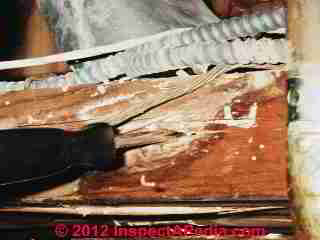 Structural Woods Damage Probing
Structural Woods Damage Probing
- POST a QUESTION or COMMENT well-nigh when, where, how & why to probe woods members to assess structural damage from insects or rot
InspectAPedia tolerates no conflicts of interest. We have no human relationship with advertisers, products, or services discussed at this website.
Woods damage assessment in buildings:
How to assess the extent of structural damage from wood destroying insects.
Wood structural member assessment for rot, insect or fire damageThis article describes methods for inspecting, probing, and otherwise assessing forest structures and wood components (floors, trim, sheathing) for harm by insects or rot.
Nosotros describe when, where, & how to inspect & probe forest components on buildings when damage (carpenter bees, carpenter ants, termites, pulverisation mail service beetles, fungal damage, rot damage) is seen, known, or suspected.
We also provide an ARTICLE INDEX for this topic, or you can try the page top or bottom SEARCH BOX as a quick manner to find data you lot need.
How to assess the extent of structural harm from wood destroying insects
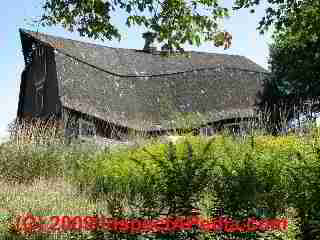
[Click to overstate any prototype]
Article Contents
- STRUCTURAL DAMAGE PROBING - CONTENTS: How to assess the extent of structural damage from forest destroying insects.
- VISUAL INSPECTION to locate show of insect damage or structural rot
- SELECT & USE PROBING TOOLS to test woods components for insect damage or rot
- DEPTH of Woods PROBING musical instrument to penetrate wood
- EXAMPLES of PROBING Woods for structural damage
- DEMOLITION for Further INSPECTION for WDI harm: when is it justified?
Assessing the extent of structural damage to wood framing members in a conventional building inspection involves the following phases and procedures:
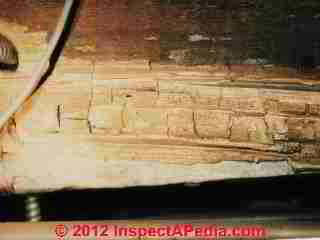
Visual inspection to locate evidence of insect harm or structural rot
Watch out: Don't presume but i kind of insect harm will be present equally the aforementioned conditions that invite one insect into a wood structure may invite others. We have found termite damage, carpenter emmet activity, and powder post beetle harm all in the same construction, on occasion even in the same wood beam or joist.
Our photo (above right) illustrates wood rot found in the same floor joist where in that location was extensive termite damage.
Pick & apply of probing tools to test wood components for insect damage or rot
Using an appropriately-chosen instrument (run into below) probe suspect or visibly damaged forest beams, joists, rim joists, sill plates, even flooring or subflooring; we start this stride in basements and crawl spaces only may find evidence to justify probing finished materials such as interior trim or wood floors.

Professionals use a wide variety of wood probing instruments of different end-diameters, sharpness, and, importantly, length, as it can be hard to attain some surfaces that really should exist examined. Our photograph (above left) illustrates using a uncomplicated screwdriver, (my dad's), to probe an expanse of visible termite damage.
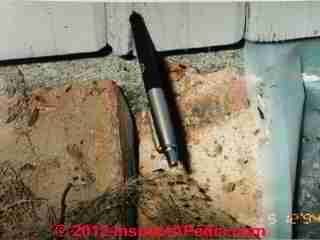
And above our pen is probing suspected rot damage at wood siding.
An example of probing a finished hardwood floor is
at TERMITE INSPECTION & Impairment.
Watch out: building inspectors and PCOs should never probe nor apply destructive inspection methods without permission of the edifice owner. Make sure that y'all accept explained the justification for any inspection techniques that involve take a chance of damage, fifty-fifty just corrective damage to the construction. However, in our Opinion, if your finger or pen easily penetrate insect or rot damaged trim, flooring, or other indoor finished surfaces, you have not caused actional impairment to that component; rather, you lot have disclosed information technology.
We arbitrated an ugly instance in which a novice dwelling inspector left screwdriver blade jam marks throughout the finished surface area of a new home. Don't do that.
The depth to which a wood probing musical instrument volition penetrate woods depends on these factors
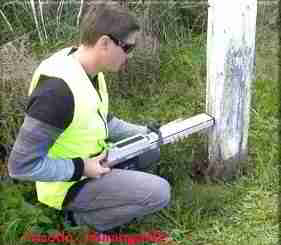
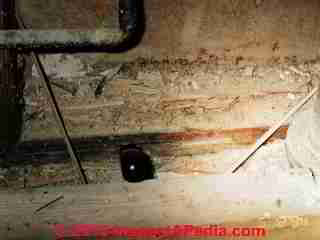
- The hardness of the wood being tested. At above left our photo illustrates micro-drilling
(explained at Woods STRUCTURE ASSESSMENT), courtesy of Paul Probett, Incodo Forensic Building Specialists [1].
At higher up right you tin can meet the butt end of our screwdriver, buried to the hilt in a termite-damaged sill plate located at the base of an interior segmentation in the basement of a New York home. The screwdriver penetrated this sill with virtually no effort. Probett calls this traditional wood inspection and probing method
"Visual and Chisel" (WOOD Axle VISUAL INSPECTION) - an approach that in our opinion is perfectly acceptable in many circumstances.

- The condition of the wood: h2o content, and well-nigh significantly the extent and depth of insect harm (or rot) nto the wood. This step is key in assessing pulverization post beetle harm as it is difficult to know earlier probing whether the damage is superficial ("topical") or much more extensive.
Our screwdriver penetrating the floor joist (photo at left) confirmed extensive termite damage in this joist that formed the ceiling over a basement utility room whose sectionalisation wall sills were besides termite infested (photograph above right).
Finding damage in both floors and ceilings of this home continued the trail of disclosure of a very extensively damaged structure.
Many inspectors and some engineers use rules of thumb about probe entry depth to form an stance most the remaining strength of the structural member and whether or not information technology needs replacement.
- The cantankerous section and area of the tip of the probe. Using a sharp pointed water ice option to probe wood is ridiculous equally the pointed tip will penetrate just about any wood and will brand unnecessary holes and damage.
Our fine wood probe (shown at below left) was fabricated past grinding off the sharp point of the ice selection to a apartment end. We utilise this probe delicately and in discrete locations such equally at the bottom of wood trim in unobtrusive areas of suspected damage.
- The strength applied to the woods exam probe. Except for the use of instrumented microdrillingv this step involves some subjectivity and is based on the experience and knowledge of the inspector.
- Encounter TIMBER Cess for details nearly microdrilling, an engineering arroyo to assessing the strength of damage-suspect structural wood.
Examples of probing wood for structural harm
Clearly the footing-off water ice pick wood probe (below correct) is finding less-astringent damage than the "to the hilt" stab of my dad's screwdriver demonstrated by our client (below left).
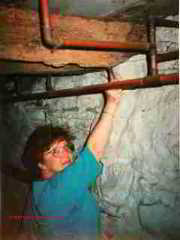
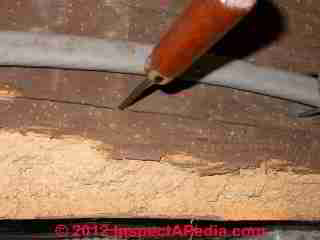
Watch out: while we advise against unwarranted cosmetic harm at a edifice interior, strategic probing of wood sills, rim joists, or floor structures (or other woods members) can disclose astringent structural harm that was otherwise not evident. At below left, fifty-fifty our pen was able to easily puncture this termite-damaged joist that had been "cosmetically-repaired" using forest putty
At below left nosotros illustrate an appropriate use of our fine wood damage probe in an expanse of suspected embrace-upward of a termite damaged oak flooring framed at footing level with no other access below.
When observing the termite damage at below right, probing adjacent wood members equally well as forth the length of the visibly attacked members is completely advisable. This termite damaged floor that was "repaired" with forest putty is described in detail
at TERMITE Damage PROBING.
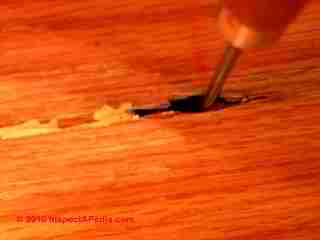
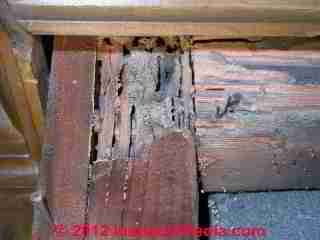
And at below left our termite damage photo illustrates a serious adventure: this floor joist looked "perfect" from its exterior, but probing disclosed that information technology was severely damaged - basically a "hollow skin" of forest.
The light colored marks at the upper edge of the joist (and suspected termite activity from other site clues) led united states of america to probe this joist bottom where it rested on the sill plate. Leverng the screwdriver disclosed the damage our photo illustrates.
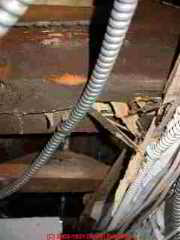
Below ,my pen, with its cap on, easily penetrated this severly-rotted joist terminate.

Demolition or removal of materials for further inspection for WDI impairment: when is it justified?
Demolition or removal of materials for further inspection for insect damage may be justified and necessary. Unremarkably powder post beetles accept attacked wood beams, typically rough cut lumber or circular "trees" used as joists or beams or sills in older homes. Nosotros don't normally need to remove floor or siding to access and assess such damage, just there are cases where it may be needed.
- Inaccessible crawl areas: In some cases such every bit where in that location is an inaccessible clamber space we may need to brand inspection or access openings to the clamber surface area, either from exterior the building or even from indoors.
- Buckled, crushed edifice siding: siding buckled at ground level over an inaccessible clamber space or slab on grade (photo, beneath left) is a likely indicator of astringent hidden rot or insect harm to the building's sills and flooring structure.
Farther inspection from outside is usually justified. Even siding buckled atop a foundation wall above ground may indicate a risk of crushing sills that merits farther investigation such equally our cement asbestos siding photo (below right).
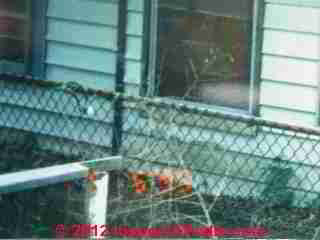
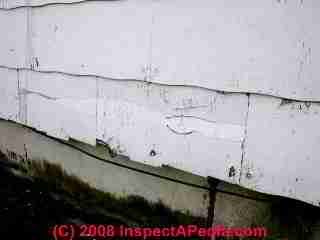
- Additional materials removal during building repairs tin can as well be expected to disembalm impairment from insects, rot, or mold. In general we remove damaged materials until in that location is a suitable safe margin of clean un-damaged materials, extending that distance of removal of woods framing where necessary for structural reasons (replacement of an unabridged fellow member for practical or cost reasons) or in special cases such
as MERULIPORIA FUNGUS Harm (photos shown just below) we remove forest for a larger safety margin, every bit much every bit ii meters across visible damage due to subconscious fungal infections.
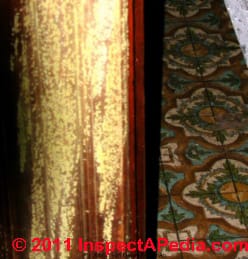
Also see the FEAR-O-METER a promotion theory to convert gamble of hidden defects & hazards into activeness thresholds, for a discussion of how an accumulation of inspection prove leads to a rational conclusion to perform invasive or desctructive inspection measures.
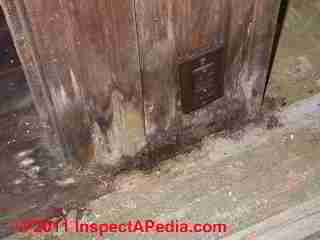
Reader Comments & Q&A
Katy
You tin can look yourself for signs of building motion - crushed supporting joists or beams, plaster cracks, sagging floors, etc. but a normal homeowner won't have the experienced eye of someone who is trained and experienced in this topic.
You may want an experienced domicile inspector, builder, or wood destroying insect inspector to make a thorough survey of the home, mapping the extent of insect damage (and rot) to the structure and giving yous an outline of the stability and prophylactic of the building and of the priority of repairs as well as, of course, telling y'all if there's show of agile infestation that needs treatment.
I'm concerned about carpenter ant harm done on our wood axle foundation in our 1840 congenital home. Non certain where to begin... Some time f the beams sound hollow when I knock on them
A handyman who is skilled at end trim carpentry
I had a painter that used masking tape to "protect" the doors etc within simply damaged the woods. What kind of professional person tin guess the toll of the damage done to repair?
Swell question, Douglas.
I have Opinion only no authoritative source. There will be no acceptable authoritative source on "how deep to probe" wood beams since as I'll explicate there is no single sensible number.
A structural engineer who specializes in wood construction probably has her own different view than mine given here.
The probing depth is a role of the softness of the wood and the type of probe used.
And some sense about where you probe and how.
Remember that we're looking for damage, not measuring woods density. In the rough approach, I used to use an ice pick only institute it penetrating more easily into soft forest than I liked. In most of my photos of woods damage probing you'll see me using an quondam apartment bladed screwdriver that was my dad'due south tool.
If using moderate force by mitt pushing the screwdriver bract against a beam, if there is no detectable damage the bract won't practice more than brand a shallow mark on the wood.
If the blade penetrates the wood for a fraction of an inch there is surface damage - typical of powder post beetles or termites or carpenter ants - with the caveat that if you don't probe where the damage is you lot won't notice the damage.
But how deep into the wood the probe tin go before nosotros would condemn a beam or mail service depends on the overall size of the wooden fellow member and its employ and location and where the damage occurs.
An inch in to a 12" axle may exist adequate in some cases.
An inch into the the tenon of a mortise and tenon connection may be more dangerous and risk breaking the connection and collapse of the construction (I've seen this happen) depending on the thickness of the tenon in post and beam construction and its position an d location.
I hope yous can see from these examples that some thought is needed and that any single numerical answer to "acceptable wood beam probing depth" would be nonsense.
For a more thoroughly engineered and sophisticated approach used in large structures, bridges, etc. that is far more than scientific and quantitative, see Paul Probett'south articles in the more-reading links above
Woods Beam FRACTOMETER TESTING
Wood Axle PILODYN TESTING
WOOD Beam MICRO-DRILLING Cess
Woods BEAM MICRO-DRILLING PROCEDURES
WOOD Axle MICRO-DRILLING EFFECTIVENESS
In this commodity series you'll too see a distinction between evaluating woods structures where probing can exist sensible and useful, and probing wood trim, paneling, etc. in homes where corrective damage is an issue.
What is the probing depth of damaged forest beams
Red
Well that'southward a new inspection "method" for me.
I speculate that the inspector has been chastised for causing corrective harm by probing wooden structural members and is looking for a method that doesn't upset a referring realtor. So she or he whacked too difficult with the hammer causing dings.
In that location is non a shred of authoritative information I have found that says that hammering on wood is an "manufacture standard".
Stance: In fact the "professional standard" (people who call abode inspection an industry are telling you something about their indicate of view) for inspecting woods structures for impairment specifies
i. visual inspection for show of damage (insect holes, mud tubes, crushing, cracking, angle, sagging, prior insect handling for termites, carpenter ants, carpetner bees)
2. probing using a suitable probe (ranges from an ice choice to a screwdriver) in areas where damage is suspected
The issue of causing cosmetic impairment to exposed wood in the finished, occupied space of a building (as opposed to a basement or crawl area where probe marks crusade cosmetic damage not considered significant) is ane familiar to any abode inspector who has ever attended a professional briefing or educational activity classes on home inspection bug.
So nosotros would criticize an inspector who punched awl holes or screwdriver blade marks or hammer dings in the surface of exposed finished area paneling, beams, moldings, etc.
Simply in an un -finished expanse that'south not the example.
I can't say whether or not I agree that at that place was a genuine justification for spending thousands of dollars on this concern. In particular, ordinary forest framing such equally 2x10 floor joists in an un-finished basement are not finish materials and should not be considered as having been damaged past hammer dings sufficiently to require replacement.
I know you agree in office with this view equally you lot characterize the damage as superficial and corrective.
Many an experienced home inspector has come across tool marks made by inspectors who were in the edifice previously and who checked framing members. When I meet those I am more-confident that others have looked with care at the structure.
I had a real estate agent hire a home inspector to inspect my dwelling house. The inspector used a process of sharply striking the wooden beams and floor joist with a hammer to evaluate moisture damage. This process resulted in damage to flooring joists and main beams. The damage was superficial and cosmetic.
But required replacement because any potential buyer would be concerned. When I had the domicile inspection franchise owner and the inspector over to my home to discuss the harm.
They attempted to convince me that sharply striking the forest was industry standard and the owner lectured me on WDI and how they were experts in their field.
There inspection caused almost $ii,000.00 of impairment to my dwelling house. I feel that both the real estate amanuensis and home inspectors are responsible for an unprofessional inspection.
Your thoughts??
Question: tin can you tell from these photographs if this is mold or "dry rot"? Our surveyor says the beam needs to be replaced.
 I have plant your website most useful, and am emailing to inquire your opinion (just from photos equally am in the UK) with regards to suspect material on a timber axle.
I have plant your website most useful, and am emailing to inquire your opinion (just from photos equally am in the UK) with regards to suspect material on a timber axle.
I appreciate yous charge for consultations and I am happy to brand a donation to your website if helpful.
I similar in a acme flooring flat in an 1850s terrace brick property in London.
We had a leak in the Leap in the roof which damaged the front wall.
At that place are some exposed beams (although covered in plaster), function of the plaster was damaged exposing the beams and I partially painted the gap 3 months ago, a few days ago I noticed odd black stains with blackness looking hairs sticking out of it (see photos).
For photos on your website it looks like dark-brown mold (simply more than black in colour), our surveyor is bold information technology is dry out rot and the axle needs to be replaced.
While information technology is hard for you to judge from photos, in your personal opinion what do retrieve it is?
Thanks so much for your help - J.Yard. 1/iv/2014, London


Respond:
A competent onsite inspection by an proficient usually finds additional clues that would allow a more accurate, complete, and authoritative answer than we tin give by email lonely.
For instance, to assess the telescopic of harm in the edifice you are describing i would want to trace the location(due south) and extent of leaks and to perform advisable probing tests to appraise the depth & extent of bodily structural harm to the beams involved. While manual probing is usually sufficient, there are too more sophisticated tools bachelor.
See details at STRUCTURAL Impairment PROBING
and at Woods Structure Cess
That said I offer these comments:
From your photograph in that location is no dubiousness that there has been protracted leakage every bit the fungal growth that I see involve mycelia or "root-hair" -like structures feature of wood destroying fungi on moisture forest. While mold growth can appear quite rapidly, when I see extended mycelial growth along with cracked wood characteristic of brown rot fungi it is reasonable to infer that the leakage in that surface area has been going on for some time.
At above left we run into fungal mycelia on what looks similar the dorsum-side of a fragment of drywall.
At above right we see the same mycelia on the side of what is probably a wood beam - indicated in your outset photo above. We as well see "cracking" in the forest feature of woods rot, typically caused by a wood-rotting fungus in the Basidiomycete family but possibly involving other fungal genera/species such as Stemonitis sp. that I often find in buildings.
I'd need to see the fungus nether the microscope to identify it - a stride that is not necessary to decide on the demand for structural repair except
where MERULIPORIA FUNGUS Harm is involved.
Every bit that fungus is a characteristic yellowish-golden, I don't see testify of it in your photographs.
"Dry out rot" does not actually mean that rot occurred with no moisture present, so utilize of the term can be misleading.
What we cannot assess from your photographs is the depth and extent of rot and thus the actual need for replacement of the structural members. Especially in older buildings where the depth of rot into large structural members is shallow, for example an inch or less in a 8x12 beam, mostly experts volition set the leak and leave the axle in service.
Depending on the structure type, and with the caveat that I am not a structural engineer nor practise I have the do good of onsite view and exploration of your detail building, I circumspection that there can be special cases where structural repair could be more urgent.
For example, if the ends of wood beams fix into a masonry structural wall are deteriorated, and specially where athwart burn down cuts were made in the wood beam ends, should the beam end go rot deteriorated there could be a chance of structural collapse.
In sum, from the very limited visual admission seen just in your photos, simply noting the credible age of leakage and show of wood rot, a more thorough investigation is needed to determine if structural repair is needed at all (other than leak repairs), and attention needs to be given to the collapse adventure points and structural connections in the building.
Beware of the "OPM" problem - a consultant who spends other people's money to reduce his or her own risk beyond that justified by the bodily site conditions.
Beware of the opposite concern - a consultant whose work is superficial and inadequate and who fails to fairly identify and assess actual hazard of serious structural damage or hazards.
Reader follow-upwardly:
Many thanks for your detailed and quick reply, it is immensely helpful and really appreciated. We have our original structural surveyor (from when we bought the property) returning next week only I note your comments re OPM...as his instinctive reaction from simply looking at the photo was that it needs replacing with a steel beam.
We will become some more expert assessments on site so we tin have a total view of what to do. I will keep you informed of our progress, - J.1000. 1/iv/2014
Reply:
The case y'all accept described, of water intrusion detected at one end of a large wood timber in an older London home, is perchance a perfect test case for Probett'south approach to woods timber strength cess described in the citation I include beneath.
Earlier tearing out an existing structural wood axle for replacement with a steel I-beam every bit your surveyor (in my stance a chip as well glibly) recommended, information technology would make sense to explore further the condition of the beam and its connections.
As my earlier e-mail explained, in a large wood timber, a modest depth of surface rot damage may not exist at all plenty to merit timber replacement. As Mr. Probett'south equipment and a knowledgable user are probably non available in London, yous may be reduced to a more traditional simply still reasonable timber assessment arroyo that includes
- removal of enough terminate materials to form a confident opinion of the location(due south) and extent(s) of and history of leakage that afflicted the axle in question .
- a visual inspection to observe h2o or rot damaged wood
- mechanical probing to explore the depth of that damage
- a thoughtful assessment of extent of timber damage and thus compromise of its forcefulness compared with the design loads involved
- conscientious attending in particular to points of connexion, as for instance in the example you lot take provided, the detected leak is at 1 end of a large axle; fifty-fifty if the overall beam is un-damaged, a failure at the connection indicate could be catastrophic.
- an interior inspection of the edifice finished-surfaces for evidence of leakage or move (stains, cracked, dislocated drywall or plaster, wall-floor separation, etc)
- an exterior inspection of the building to identify its leak points and leak history, with an center to identifying other areas where there may be un-discovered leakage, rot, and structural impairment that need to exist investigated.
My business organization in writing this follow-up notation is to exist sure to point out that on a edifice built in the 1850'due south there will certainly have been leaks through its lifetime; depending on leak location, elapsing, severity, building materials, inteiror finishing, building occupancy, building maintenance level and like variables, such leaks tin can get un-recognized for a long fourth dimension, perhaps allowing damage to be significant. On the other mitt, and where my comments began, superficial impairment is probable not to justify costly repairs.
Because this case is a fit application for methods he is developing, I have referred Paul Probett to our public discussion at https://InspectAPedia.com/construction/Structural_Damage_Probing.php
If you agree I'd similar to also send him a copy of our correspondence. Encounter
- Paul Due south. E. Probett, Clinton S. Craig, Blake J. Probett, "In Situ Structural Timber Forcefulness Measurement Advances Using Qualitative Resistography and Quantitive Resisto-Fractometry" [PDF] [USFPL newspaper, 730KB], Paul S. E. Probett MIFPI, AsocRICS, MBOINZ, MNZIBS, NZCB. Clinton Due south. Craig Blake J. Probett INCODO Ltd, Tauranga, New Zealand, mail2us@incodo.co.nz, 18th International Nondestructive Testing and Evaluation of Wood Symposium - Madison, WI Sept 2013, http://world wide web.forestprod.org/symposium2013/
discussed in our article
serial WOOD STRUCTURE ASSESSMENT
Reader follow-up:
Daniel this is incredibly helpful, it is really good to get an understanding of all the various things to consider and from an unbiased source, it seems clear that each state of affairs is different to the last and at that place is no 'boiler plate' solution that should be instantly applied.
While I take no expert knowledge of any of this, my instinct was that every scenario should be considered before the most invasive selection of a steel beam, particularly from the structural reason that we are in an old property which has a tendency to move or aggrandize a bit (unfortunately a expletive of Islington in London all being congenital on clay) and hence the sheer weight of a steel axle might present its own problems on a house designed for timber and bricks, however as you rightly mentioned - surveyors, in the u.k. at least, want to present the best pick to cover their personal liability regardless of price
I certainly come up with the view that whatever is necessary should be washed (equally the consequences of non doing so could be fatal) simply the right solution should be plant Please feel free to laissez passer on our correspondence to Mr Probett - J.M. 1/five/2014
...
Continue reading at Forest STRUCTURE ASSESSMENT or select a topic from the closely-related articles beneath, or encounter the complete ARTICLE INDEX.
Or come across these
Forest Structure Testing Manufactures
- WOOD Structure Cess - home
- CRACKS CHECKS SPLITS in BEAMS, LOGS & POSTS
- MERULIPORIA Mucus Impairment
- ROT, TIMBER FRAME
- ROT, TIMBER Cess
- SPLITS & CRACKS in STRUCTURAL Forest BEAMS
- STRUCTURAL DAMAGE PROBING
- TABLE of TREE Decay DETECTION EQUIPMENT
- WOOD Beam VISUAL INSPECTION
- WOOD BEAM MICROBIOLOGICAL ASSESSMENT
- Woods BEAM FRACTOMETER TESTING
- WOOD BEAM PILODYN TESTING
- WOOD Beam MICRO-DRILLING Cess
- WOOD BEAM MICRO-DRILLING PROCEDURES
- Wood Axle MICRO-DRILLING EFFECTIVENESS
- Forest BEAM ROT ASSESS: MOISTURE METERS
- Woods Axle ROT ASSESS: THERMOGRAPHY
Suggested citation for this web page
STRUCTURAL Harm PROBING at AuditApedia.com - online encyclopedia of building & environmental inspection, testing, diagnosis, repair, & problem prevention advice.
Alphabetize to RELATED Manufactures: Commodity INDEX to INSECT DAMAGE
Or utilize the SEARCH BOX establish below to Inquire a Question or Search InspectApedia
Or encounter
INDEX to RELATED Manufactures: Commodity Index to Edifice STRUCTURES
Or apply the SEARCH BOX found below to Ask a Question or Search InspectApedia
...
Enquire a Question or Search InspectApedia
Try the search box just below, or if yous prefer, post a question or comment in the Comments box below and we will respond promptly.
Search the InspectApedia website
Note: appearance of your Annotate below may be delayed: if your comment contains an epitome, web link, or text that looks to the software every bit if information technology might be a web link, your posting will appear afterward information technology has been approved past a moderator. Apologies for the delay.
Technical Reviewers & References
Click to Show or Hide Citations & References
Publisher InspectApedia.com - Daniel Friedman
Source: https://inspectapedia.com/structure/Structural_Damage_Probing.php
Posted by: martinezwagood.blogspot.com


0 Response to "How To Repair Crack In Wood Beam Outdoor"
Post a Comment